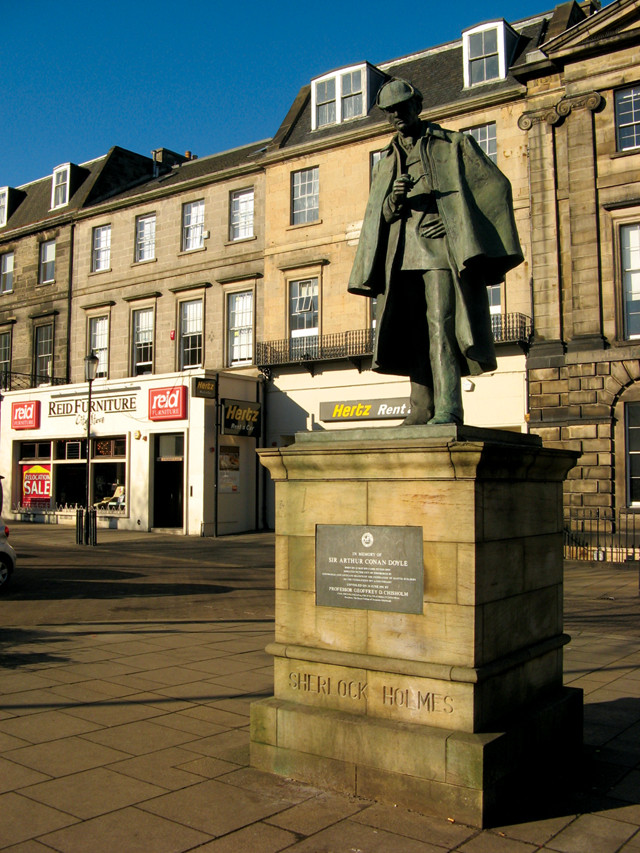
by Patrick Morgan Wednesday, July 6, 2016

Credit: ©iStockphoto.com/mbbirdy.
In a bean field outside the city of Freiburg im Breisgau on the western edge of Germany’s Black Forest, Eva Disch lay dead, strangled. Her blue and red silk scarf may have kept the chill off her neck earlier on that October day in 1904, but now it was wound too tightly, a tourniquet around her neck. The only clue to the death of the local seamstress was a dirty handkerchief discarded near her body. With little evidence to go on, investigators turned to Georg Popp.
Trained as a chemist, Popp ran a commercial consulting laboratory in Frankfurt, Germany. His lab had previously focused on microscopic and chemical analyses of water, food and bacteria, but for the past four years Popp had been using his expertise to fight crime as well. And in October 1904 — in what is widely considered the first application of forensic geology to solve a murder — Popp solved the mystery of who killed Eva Disch.
Using a microscope, Popp inspected the mucus on the handkerchief, identifying snuff, coal and several mineral grains, including hornblende. In addition, “red and blue silk threads, consistent with the scarf used to strangle Eva Disch, clung to the handkerchief, glued to it by shiny strings of nasal secretion,” writes forensic historian E.J. Wagner in her 2006 book, “The Science of Sherlock Holmes.” This particular assemblage of materials led investigators to suspect Karl Laubach of committing the crime, says Elisa Bergslien, an earth scientist at Buffalo State College in New York who teaches forensic geoscience and is the author of the forthcoming book, “An Introduction to Forensic Geoscience.”
An ex-Foreign Legionnaire, Laubach split his work between a coal-burning gasworks and a local gravel pit. He was also known to use snuff. Examining grime from underneath Laubach’s fingernails, Popp discovered coal and hornblende particles, along with telltale fragments of red and blue silk.
Popp also examined Laubach’s pants under the microscope, which, he found, had preserved two distinct soil layers. Crusted directly onto the fabric of the pants was a layer containing minerals from the soil in the bean field, where the murder had occurred. Atop this layer was a smear of crushed mica grains that matched the mineralogy and particle size of the soil along the path stretching between Eva Disch’s body and Laubach’s house. In looking at the “microstratigraphic layering of different soils” on Laubach’s pants, Popp came up with a sequence of events that made sense, says Alastair Ruffell, a geographer at Queen’s University Belfast, and author of the 2008 book “Geoforensics.” Laubach acquired the first soil layer at the murder scene, and then picked up the mica-rich mud during his dash back home. Popp, Ruffell says, “gathered evidence that would still stand in a court today.”
Confronted with such an overwhelming mélange of evidence, Laubach confessed. The motive isn’t known.

Statue of Sherlock Holmes in Edinburgh, Scotland, near the birthplace of Sir Arthur Conan Doyle, Holmes' creator. The very idea of forensic geology is said to have come from Doyle's stories. Credit: ©Jonathan Oldenbuck, Creative Commons Attribution-ShareAlike 3.0 Unported.
At the time, the Eva Disch case was celebrated as a triumph of science over crime, with Frankfurt newspapers printing headlines such as “The Microscope as Detective.” In Popp’s eyes, the case helped to further validate the fledgling discipline of forensic geology — the science of analyzing geological materials to solve criminal cases. Forensic geology seeks to determine the origin of minerals, soils and other substances to show how likely it is that a sample was derived from a given place, writes famed forensic geologist and Rutgers University professor emeritus Ray Murray, in his 2004 book “Evidence from the Earth.”
The Eva Disch case has long held a special position in the history of forensic geology; it’s been called the real-world inauguration of theories that had only before existed in books — such as the fictional Sherlock Holmes mysteries.
“The idea of professional geologists applying their field to criminalistics began, like applications of many sciences to this area, with the writings of Sir Arthur Conan Doyle,” Murray writes in “Evidence from the Earth.” From the very first Sherlock Holmes story — “A Study in Scarlet” in 1887 — Doyle describes Holmes’ singular abilities to, at a mere glance, link mud-stained clothing to specific locations in London. Doyle’s fictional seeds then sprouted into reality with the 1893 printing of Hans Gross’ “Handbook for Examining Magistrates,” a compilation of criminal investigation methods that included the use of microscopes to analyze dust, dirt and other materials. “Dirt on shoes can often tell us more about where the wearer of those shoes had last been than toilsome inquiries,” Gross writes.
However, there are no records indicating that any cases were solved using forensic geology between the handbook’s 1893 publication and Popp’s microscopic examination in the 1904 Eva Disch case. Thus, the Disch case is traditionally considered the “first example of earthen materials used as evidence in a criminal case,” Murray writes.
Despite its customary stature as the first forensic geology case, the Eva Disch case actually has a couple of predecessors that have recently come to light. In 1856, there’s evidence that investigators used geologic samples to solve a crime on the Prussian railroads: After discovering that a barrel originally containing silver coins had been emptied and filled with sand, investigators compared the sandy soil with soil along the railroad route to determine the station where the crime was committed, as Ruffell writes in “Geoforensics.” An even older newspaper headline, entitled “Discovery and Punishment of Murder by Circumstantial Evidence,” details how a William Richardson was sentenced to execution in Scotland in the spring of 1787 partly based on evidence linking the mud on his stockings to mud at the scene of the crime.
Regardless of whether the Eva Disch case was the first criminal case using geologic materials as evidence, it was “an important step in establishing forensic geology, leading to other more difficult cases,” Bergslien says. Following the 1904 case, Popp was sought out for more cases, including the 1908 murder of Margarethe Filbert near Rockenhausen, Bavaria. In that case, Popp reconstructed a suspect’s movements on the day of the murder by examining the sequence of soil layers on his shoes. This case established soil examination and forensic geology in the court system, Bergslien says.
By 1935, the FBI was regularly working with soils. And today, although “exact figures are not available,” Murray writes, “it is safe to estimate that, annually, forensic geologists study thousands of cases in North America alone, where geologic material, usually soil, is now routinely collected during investigations.” Forensic geology has even entered the realm of pop culture — where it is routinely seen on television crime shows like “CSI.”
© 2008-2021. All rights reserved. Any copying, redistribution or retransmission of any of the contents of this service without the expressed written permission of the American Geosciences Institute is expressly prohibited. Click here for all copyright requests.